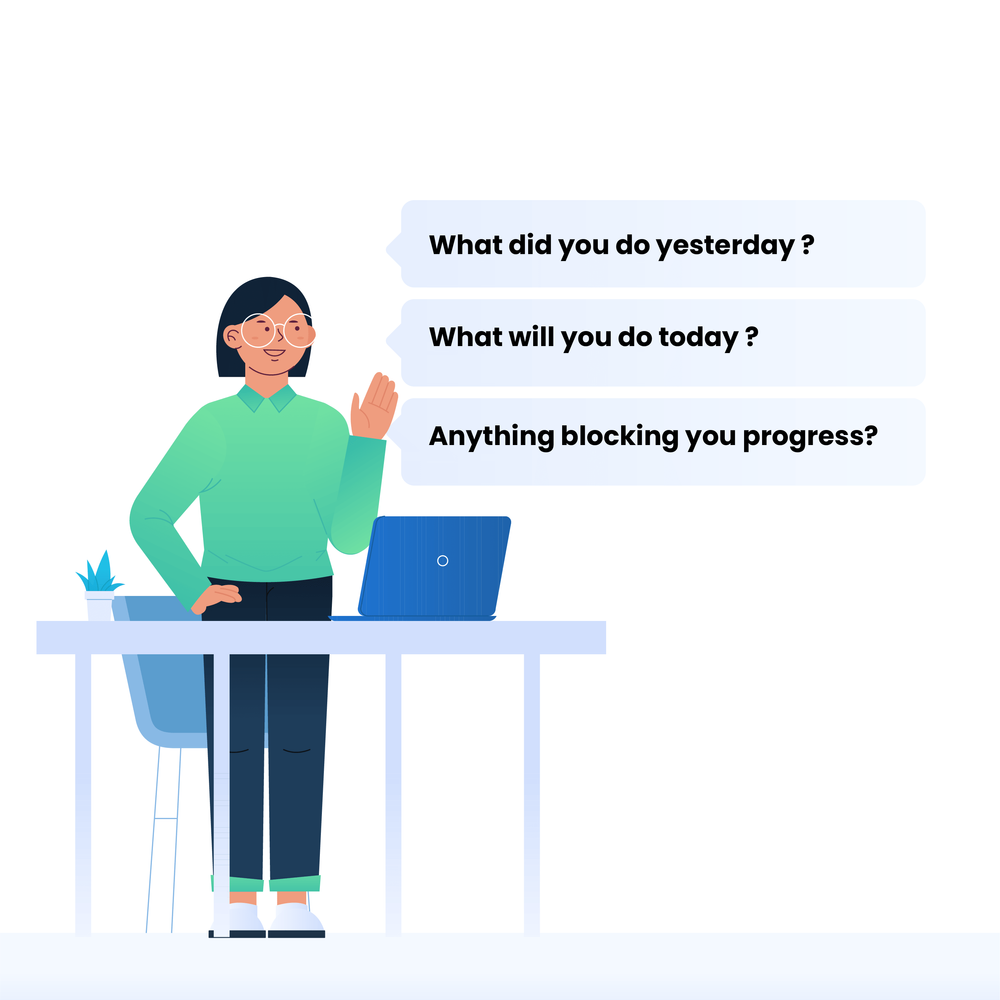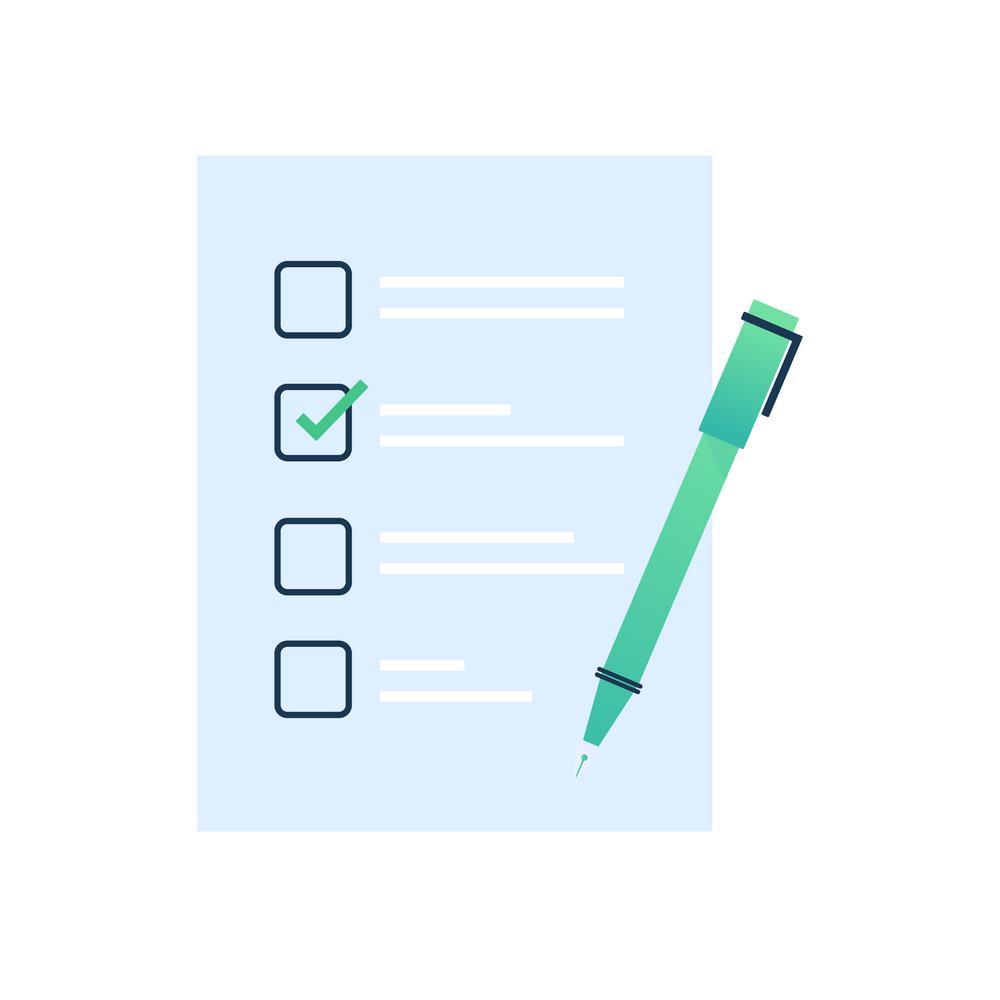Daily Standup Meeting: the Ultimate Guide (Standup Agenda, Best Practices, Standup Questions and More)

In the world of Agile, the daily standup meeting is an untouchable necessity. The focal point around which the whole team orbits, it is hard to overstate how useful these events are for keeping everyone focused, productive, and pulling in the same direction.
What is a standup meeting exactly?
Very simply, a daily standup meeting is a quick team get-together done while standing. The meeting’s main aim is to review ongoing work and look at tasks that are about to start or have just been completed. Keeping the team literally on their feet helps to focus minds and keep these meetings short and sweet. It also works to counter the more traditional thinking that comes from boardroom or round-table meetings.
Standup meetings are great for teams looking to generate fresh concepts and make ideation sessions more effective and productive. The daily nature of these standups creates a rhythm that’s really important for Agile iterations — guaranteeing that projects constantly move forward and never grind to a halt.
Standup meetings are, on the face of it, pretty simple affairs. They are easy to implement, once you know how. But as with all Agile principles they do require a little practice and fine-tuning, to reap the best rewards.
This guide will take a deep dive into the world of daily standup meetings. We’ll explore what they are for, how to get the most out of them, and what can go wrong — plus everything else you might need to know to make them succeed.
So with that in mind, let’s get started!
What is the purpose of a standup meeting?
Back in the 60s, managers and executives spent around 10 hours a week in meetings. Over the last 60 years meetings have shifted, grown, and become more frequent. Today, we can spend anywhere from 35% to 50% of our working week meeting with colleagues.
So enter the daily standup. When standups first came on the scene, they were designed to cut down on the amount of time spent (wasted?) in meetings, and make teams more productive. Committing to a time-saving meeting once every day might seem counterintuitive at first. But the standup’s bitesize, straight-to-the-point agenda is more efficient versus other meeting formats. It’s arguably also more inspiring than longer meetings held less regularly, too.
What do you do in a standup meeting?
The point of a daily standup is to go over upcoming, ongoing, and completed tasks. They are a great way to ensure that everyone on the team:
- Is aware of what their teammates are doing
- Understands what the team is trying to achieve on the whole
- And has an opportunity to share information, tips, or knowledge that might be helpful.
These short, sharp meetings help track workflow and stay on top of the status of the overall project. They ensure that all the different moving parts of a team and project fit together properly, and help avoid overlap or missed opportunities. Most importantly, they encourage team members to think in alternative, more agile ways. The result? Exciting, beyond-the-comfort-zone ideas that may not have arisen in the boardroom.
Why not just use an instant messenger?
In today’s digitally-driven world — where software has made connecting teams easier than ever — it’s legitimate to wonder why face-to-face standups are any better than a Slack chat, for example.
Bringing everyone together, in the same room, remains an incredibly important part of forming and maintaining a good working relationship within a team. Studies show that people build stronger relationships when they meet face-to-face. And standups help everyone come together and feel like a team — even if they work separately.
Working in a fully remote or work-from-home organization? No stress. Standups are within your reach too! We’ll outline the tools you need towards the end of this guide.

What are the 3 daily standup questions?
Anyone who has taken part in a daily standup meeting knows that there’s a fairly standard, daily standup meeting format. This revolves around three key questions which provide the focus for the meeting:
- What did you do yesterday?
- What will you do today?
- Anything blocking your progress?
The fundamental elements of these questions are pretty simple — as is often the way in Agile. The three questions are designed to check in on project progress and make sure everyone’s working as productively and effectively as possible. They double-check that everyone’s clear on what’s already been done, what needs to be completed, and what help members of the team might need from each other.
That said, there’s a bunch more benefits of the three questions — benefits that Agile teams often miss.
‘What did you do yesterday?’ can do far more than just update the team on an individual’s progress. It can highlight areas and working practices that aren’t as efficient as possible or that could benefit from additional resources. Together this shows where an organization isn’t working as effectively as it could be.
This first standup meeting question can help teams complete projects more quickly, too. Why? Because team members who finish similar tasks faster than their colleagues can share insights and advice on how they are working.
It might also shine a light on poor planning, too. Team members who don’t have enough to do — or who weren’t able to complete tasks for some reason or other — will share their concerns, triggering the team to reorganize and recalibrate to set things straight.
‘What will you do today?’ also brings far more to the table than just a rundown of team tasks for the coming day. You can examine upcoming tasks — eliminating any that don’t actively contribute towards the team’s goal and project success.
You can crowdsource solutions to particular problems, sharing knowledge and information to make the whole team function better. Finally, you can address unexpected or unforeseen planning or project management issues or glitches. Maybe two colleagues are accidentally working on the same task, a critical task has gone unassigned, or some crucial dependencies need re-evaluation.
The final question, ‘Anything blocking your progress?’ is probably the simplest and most straightforward. It gives the team a forum to air and address pain points and project blockers; working collectively how best iron them out.

10 standup meeting best practices
The three-question standup meeting format gives structure to daily standups. But there’s still scope for these meetings to go off track and lose their effectiveness. We’re all only human!
Below are some scrum standup meeting best practices. These will help you run a daily standup the right way — so they never become an everyday nuisance, to be tolerated within your teams.
1. Keep things uncomfortable
Daily standup meetings are called that for a reason — standing up helps keep everyone focused on the task at hand and prevents anyone from getting too relaxed or off topic. It might seem a little authoritarian, but a little discomfort means that meetings are more likely to be brief, and less likely to drift off-track.
2. Keep them brief
Daily standup meetings are meant to be short and to-the-point. They are not meant to be long, rambling get-togethers, but rather a quick, effective way to bring the team together and make sure that everyone’s on the same page. Most daily standups run for about fifteen minutes. Long enough for everyone to provide an update and report any difficulties they are facing, but not too long to eat into your day. Longer meetings often indicate a breakdown in team communication or bigger issues to be resolved.
3. Focus on the three questions
You should obviously feel free to cover everything that needs to be dealt with. But staying focused on the three-question format helps make sure the meeting’s main goals are achieved.
Moving too far away from these three topics tends to lead to lengthy, irrelevant digressions, and disturbs the flow of the meeting. When in doubt, write each question on a Post-It or piece of paper and place it in the center of your teams. Visual reminders work well to steer everyone back to the agenda!
4. Don’t forget about remote team members
Remote colleagues can still add value to your standup — and it is important not to exclude them. A simple video call on one person’s laptop brings remote workers into the loop. And if you’re all working remotely, the daily standup format is just as easily achieved via Zoom or Microsoft Teams as it is in an office kitchen!
5. Follow a routine
Whenever possible, hold your daily standup meetings at the same place and the same time every day. This helps form a habit and rhythm in your team’s weekly workflow.
Try not to skip days or miss meetings — even if you’ve not got much to discuss. Canceling standups will throw off the routine and disrupt the scrum process. Consistency is a hugely important aspect of Agile methodologies, making this standup best practice tip one of the most essential!
6. Take advantage of digital tools
Standup meetings are best held face-to-face, but that doesn’t mean that you can’t leverage digital tools to help make them even more effective. Meeting software and apps are a great way to ensure that the learnings and outcomes aren’t lost, that things are followed up as needed, and that remote team members are included as well.
There are a few particularly brilliant tools, which we’ll recommend a little later in this guide.

7. Stick to an agenda
A standup meeting can rip up the traditional round-table rulebook, true. But having an agenda for your standup is still an extremely useful way of staying on track and covering everything you need to cover.
A daily standup meeting agenda lets you create a bespoke meeting style that fits your team’s goals. It helps to ensure that all the personalities in the team are catered for, and makes certain that everything that needs to be addressed during the meeting gets its air time.
8. Be strict with off-topic updates
The facilitator has a really important role to play during daily standup meetings, and it is their responsibility to ensure that the meeting doesn’t veer off course.
Remember: standups should be quick conversations, not in-depth analyses. And the facilitator — or Scrum Master — may need to fight to keep things focused. Identify issues for sure, but work out who is best to handle them, then make that a follow-up task and move on.
9. Make sure everyone has speaking time
Plenty of standups use speaking chips or tokens, as well as allotted time segments, to give everyone a chance to contribute. Standups are meant to be communal forums for discussion, not managerial download sessions. You need to be proactive — encouraging the more dominant members of the group to wait their turn, so the quieter members of the team can have their say.
10. Follow up!
It is pretty basic: your daily standup meetings are a waste of time if no-one follows up. The meetings themselves don’t get anything done. You need to be rigorous in ensuring that everyone with an action or task from each day’s meeting works towards solving or completing it in the near future.

Common pitfalls of a standup meeting
While it’s important to know your standup best practices, you also need to know what inefficient standup meetings look like too. Learning what doesn’t work — the common standup errors and pitfalls — is your first step to avoiding them.
Plenty of teams, even those who are well versed in Agile, still don’t think that daily standup meetings are time well spent. This is usually because they aren’t run properly, and as a result no-one feels the benefits.
Sounds familiar in your organization? Maybe one of the following issues is to blame.
Sharing non-relevant information
Nothing ruins a standup faster than getting drawn off topic.
Perhaps you spend time discussing something beyond the scope of your project, or that little bearing on your team’s to-do list. Either way, these diversions can have a serious impact on the effectiveness of your meeting.
Issues that are only of relevance to one or two people need to be dealt with outside the standup, so bear that in mind.
Long meetings
Overly long standups leave people tired, bored, and uninspired. A lengthy meeting will just make it that much harder to achieve any actions assigned — meaning that most of the time spent has been a waste.
If the meeting involves too many people, or the facilitator is not in control, standups can quickly digress. So keep things moving along at all times.
Problem-solving during the meeting
Daily standup meetings are for updates and identifying issues — not for addressing them. Don’t be tempted to troubleshoot during the meeting, as this can lead to pitfalls 1 and 2 above!
Instead, assign problem-solving actions to be carried out after the meeting adjourns. That safeguards the effectiveness and engagement of your daily standup.
Poor scheduling
Making sure your daily scrum meeting works for all the personalities in your team can be tricky, but it’s important to get right. You need to make sure the daily standup is convenient for everyone, otherwise it will always be seen as an annoyance — not an essential.
Failure to listen
We’ve all lost concentration in a meeting before; tuning out what’s being said. We’ve also all spent more time thinking about what we’re going to say, rather than listening to our colleagues.
While they’re understandable, these behaviors should be avoided too. It’s important that the meeting fulfills its basic function of sharing information, so a facilitator should be doing everything they can to keep everyone actively engaged.
Lack of routine
A set routine for your standup meetings not only embeds it in the team’s working process, it also facilitates attendance. If your standups constantly change time or venue, people may end up missing or skipping them, reducing their effectiveness.
Not admitting failure/blockers
When was the last time you admitted to a failure or imperfection? It doesn’t come easily, does it? But leveraging the skills of the entire team to deal with issues is one of the main advantages of daily standups. And it’s vital that people don’t feel embarrassed or uncomfortable when raising their blockers.
3 must-have apps for successful standups
As we mentioned earlier, digital tools can have a huge impact on your daily standup meetings. Using the right app or software can make a real difference to how well your daily standups run, how successful their outcomes are, and how useful they are to all attendees.
In our opinion there are three must-have apps for successful, effective standups. We’ve outlined how they help teams with their daily standups below:
Friday
Friday is designed to automate your regular standup meetings. Users can pre-populate the app with relevant information, and then prompt all team members with questions before the meeting begins.
As well as circulating questions and agendas, the Friday workflow allows remote workers to contribute to the meeting by email or via a Slack integration, too.
Standuply
Standuply operates as an automated digital assistant for your daily standup meetings.
This standup bot uses predefined templates to prompt and run asynchronous or scheduled meetings, as well as attaching reports and follow-up actions. The meetings can be conducted via text, voice, or video as well — keeping off-site teammates in the loop.
Standuply also provides access to a library of mentoring resources, where agile teams can request support or advice from a specific mentor.
Geekbot
Geekbot offers something a little different — perfect for fully remote teams or groups who want to hold standup meetings on the fly.
Hosted entirely in Slack, Geekbot prompts teammates to answer the three standup questions via instant message. The bot can nudge colleagues to respond, and provides an archive of answers and responses — making it easy for Scrum Masters to review previous meetings, actions, and outcomes. Geekbot also provides an exceptional amount of data analysis, so meetings can be continually tweaked, improved, and optimized.
The daily standup meeting is an important aspect of any agile team’s work. It is a simple process, but needs work and constant management to be most effective.
Done right, a daily standup can have a hugely positive impact on your team’s productivity, and drive success in every project you undertake. So why not give it a go — one day at a time?